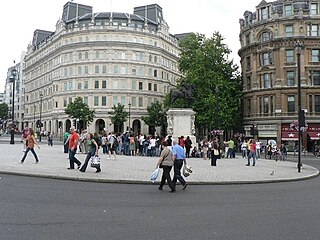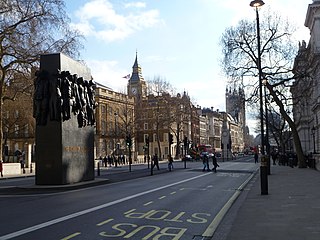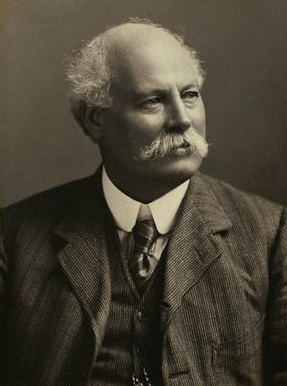
Charing Cross is a junction in Westminster, London, England, where six routes meet. Clockwise from north these are: the east side of Trafalgar Square leading to St Martin's Place and then Charing Cross Road; the Strand leading to the City; Northumberland Avenue leading to the Thames Embankment; Whitehall leading to Parliament Square; The Mall leading to Admiralty Arch and Buckingham Palace; and two short roads leading to Pall Mall. The name also commonly refers to the Queen Eleanor Memorial Cross at Charing Cross station.

The Eleanor crosses were a series of twelve tall and lavishly decorated stone monuments topped with crosses erected in a line down part of the east of England. King Edward I had them built between 1291 and about 1295 in memory of his beloved wife Eleanor of Castile. The King and Queen had been married for 36 years and she stayed by the King’s side through his many travels. While on a royal progress, she died in the East Midlands in November 1290. The crosses, erected in her memory, marked the nightly resting-places along the route taken when her body was transported to Westminster Abbey near London.

Leicester Square is a pedestrianised square in the West End of London, England. It was laid out in 1670 as Leicester Fields, which was named after the recently built Leicester House, itself named after Robert Sidney, 2nd Earl of Leicester.

Finchley is a large district of north London, England, in the London Borough of Barnet. Finchley is on high ground, 11 km (6.8 mi) north of Charing Cross.

Whitehall is a road and area in the City of Westminster, Central London, London, England. The road forms the first part of the A3212 road from Trafalgar Square to Chelsea. It is the main thoroughfare running south from Trafalgar Square towards Parliament Square. The street is recognised as the centre of the Government of the United Kingdom and is lined with numerous departments and ministries, including the Ministry of Defence, Horse Guards and the Cabinet Office. Consequently, the name "Whitehall" is used as a metonym for the British civil service and government, and as the geographic name for the surrounding area.

Dame Alice Ellen Terry,, was a leading English actress of the late 19th and early 20th centuries.

Sir Henry Irving, christened John Henry Brodribb, sometimes known as J. H. Irving, was an English stage actor in the Victorian era, known as an actor-manager because he took complete responsibility for season after season at the West End's Lyceum Theatre, establishing himself and his company as representative of English classical theatre. In 1895 he became the first actor to be awarded a knighthood, indicating full acceptance into the higher circles of British society.

Sir Thomas Brock was an English sculptor and medallist, notable for the creation of several large public sculptures and monuments in Britain and abroad in the late nineteenth and early twentieth centuries. His most famous work is the Victoria Memorial in front of Buckingham Palace, London. Other commissions included the redesign of the effigy of Queen Victoria on British coinage, the massive bronze equestrian statue of Edward, the Black Prince, in City Square, Leeds and the completion of the statue of Prince Albert on the Albert Memorial.

The equestrian statue of Charles I at Charing Cross, London, is a work by the French sculptor Hubert Le Sueur, probably cast in 1633. It is considered the central point of London.

The Imperial Camel Corps Memorial is an outdoor sculpture commemorating the Imperial Camel Corps, located in Victoria Embankment Gardens, on the Thames Embankment to the east of Charing Cross station, in London, England. The unit of mounted infantry was created in December 1916 from troops that had served in the Gallipoli campaign in the Dardanelles.

The Queen Eleanor Memorial Cross is a memorial to Eleanor of Castile erected in the forecourt of Charing Cross railway station, London, in 1864–1865. It is a fanciful reconstruction of the medieval Eleanor cross at Charing, one of twelve memorial crosses erected by Edward I of England in memory of his first wife. The Victorian monument was designed by Edward Middleton Barry, also the architect of the railway station, and includes multiple statues of Queen Eleanor by the sculptor Thomas Earp. It does not occupy the original site of the Charing Cross, which is now occupied by Hubert Le Sueur's equestrian statue of Charles I.

The Marlowe Memorial is a statue and four statuettes erected in memory of the playwright and poet Christopher Marlowe in 1891 in Canterbury, England. The memorial was commissioned by a Marlowe Memorial Committee, and comprises a bronze statue, The Muse of Poetry sculpted by Edward Onslow Ford, standing on a plinth decorated with statuettes of actors playing Marlowe roles. The statue is now situated outside the city's Marlowe Theatre.













